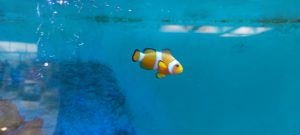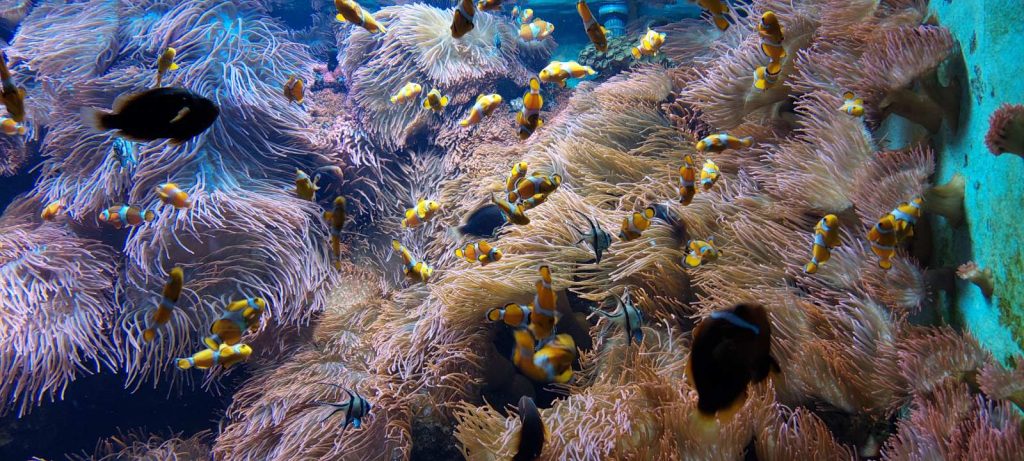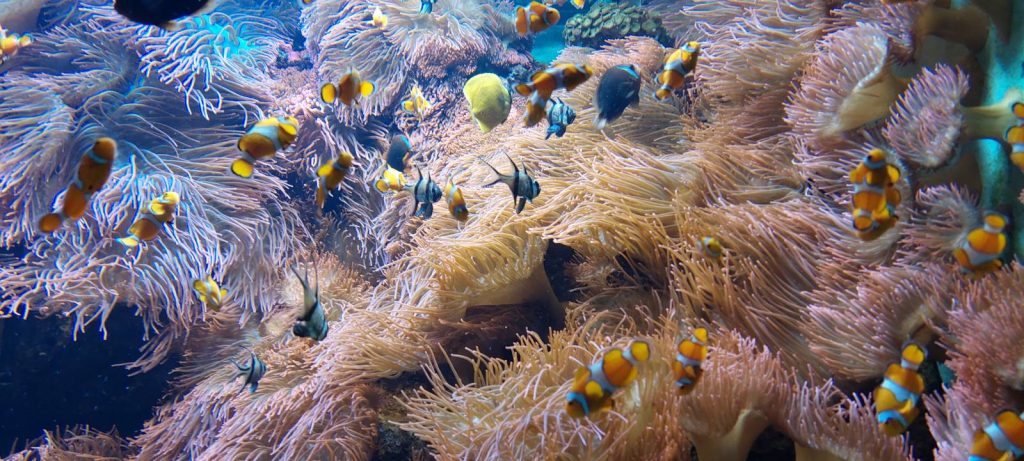Clownfish, scientifically known as Amphiprioninae, is a fascinating inhabitant of tropical seas. With its vibrant appearance and unique symbiosis with sea anemones, it has attracted the attention of nature lovers and researchers alike. These small fish, typically 10 to 18 centimeters long, have a distinctive body structure characterized by a bright orange or yellow base color and crossed by white or black stripes or bands. Not only is their appearance striking, but it also serves an important purpose – camouflage in the busy waters of tropical coral reefs.
But what makes clownfish particularly fascinating is their close relationship with sea anemones. Dangerous to most other sea creatures, these spiny sea creatures provide clownfish with protection from predators. The fish are immune to the stinging poison of the anemones and live within their tentacles. This symbiosis is a remarkable example of nature’s adaptability, in which both partners benefit from each other. The anemones receive nutrition in the form of clownfish remains and protection from predators while the fish find a safe home.
Appearance of the clownfish
Clownfish, also known as anemonefish, are characterized by their striking and colorful appearance. Here are some of the distinctive features of their appearance:
- Vibrant Colors: Clownfish are known for their vibrant colors. They typically have an orange to orange-yellow base color with white stripes or bands along their body. Some species may also have a bright orange body with black stripes.
- Compact Body: Their bodies are oval and relatively flat, which helps them hide in the narrow cracks of coral reefs.
- Fins: These fish have a dorsal fin, anal fin, and pectoral fins that allow them to move gracefully in the water. The anal fin is often longer and is used for stabilization and maneuverability.
- Distinctive stripes: The stripes on their body are an unmistakable feature. These stripes are not only decorative, but also help camouflage in the colorful reef environments.
- Mouth and Eyes: Clownfish have a small mouth surrounded by powerful jaws. Their eyes are relatively large and have striking black markings that often look like glasses.
- Small Size: These fish are generally on the small side. They usually reach a length of around 10 to 18 centimeters, depending on the species.
- Gender differences: There are gender differences in size for these fish. Female clownfish are often larger than males.
- Variations by Species: There are different types of clownfish, and depending on the species, the colors and patterns may vary. For example, the false clownfish (Amphiprion ocellaris) typically has three white stripes, while the true clownfish (Amphiprion percula) has three narrow, dark stripes on an orange body.

Clownfish are also fascinating sea creatures because of their interesting behavior and their unique symbiosis with sea anemones.
Where do clownfish live?
In addition to being popular characters in animated films like Finding Nemo, clownfish are amazing creatures that live in the warm waters of the tropical Indo-Pacific. The origins and evolution of these colorful fish are just as fascinating as their striking appearance and unique social behavior. In this article, we take a look at the origins of the clownfish and its remarkable evolutionary history.
The “tropical Indo-Pacific” refers to a geographical area in the ocean that includes the tropical part of the Indian Ocean and the western part of the Pacific Ocean. This area extends roughly from the east coast of Africa and the Arabian Peninsula in the west to the islands of the western Pacific and the coasts of Australia and Indonesia in the east.
The tropical Indo-Pacific is known for its warm waters rich in biodiversity, including many coral reefs, fish species, marine animals and plants. This area is of particular interest to divers and marine biologists as it is home to some of the most diverse and species-rich marine ecosystems in the world.
This part of the ocean is therefore of great importance for understanding marine biodiversity and the conservation of marine life.


The taxonomic classification
The clownfish, scientifically known as Amphiprioninae, belongs to the damselfish family (Pomacentridae). The damselfish are a diverse group of fish found in warm ocean waters worldwide. Within this family, clownfish form a special subfamily. There are about 30 different species of these fish, the most famous of which is undoubtedly the false clownfish (Amphiprion ocellaris).
The evolutionary story
The exact origins of clownfish are still the subject of scientific research and discussion. The evolution of fishes is studied due to the limited fossil records and the variety of species in the group. Nevertheless, there are some important findings.
It is believed that millions of years ago, the ancestors of “Nemo” developed a way of life, independent of other damselfish, that brought them into close relationships with sea anemones. Over the course of evolution, they developed immunity to the poison of anemones and began to live in their protective tentacles.
The striking coloring of these fish not only serves aesthetic pleasure, but also serves a practical purpose. The bold colors serve as camouflage in the colorful and dangerous reef environments in which they live.
The threats and the protection
Today, “Nemos” are endangered in many parts of their range, primarily due to the destruction of coral reefs and illegal capture for the pet trade. Protecting these fascinating fish and their habitats is of utmost importance to ensure that future generations have the opportunity to experience the beauty and uniqueness of clownfish.
These fish are not only a fascinating example of the evolution and diversity of life in the oceans, but also an important reminder of the importance of preserving marine ecosystems. By protecting their habitats and regulating the trade in clownfish, we can help ensure that these colorful inhabitants of the sea will continue to delight and fascinate for generations to come.
The relationship between clownfish and sea anemones
The relationship between clownfish and sea anemones is one of the most fascinating and symbiotic partnerships in the underwater world. This close bond has captured both the curiosity of marine biologists and the hearts of nature lovers worldwide.
Sea anemones are spiny, animal-like creatures that thrive in tropical ocean waters. They have long, poisonous tentacles that they use to catch and kill their prey. Normally this would be a life-threatening scenario for most fish. However, this is where the clownfish comes into play.
“Nemos” are small, colorful fish that are usually found living in close association with sea anemones. This relationship offers benefits for both parties:
- Protection: One of the most amazing properties of clownfish is their immunity to sea anemone venom. The fish can stay within the anemone’s tentacles without being injured. These safe havens offer them protection from predatory sea creatures who are deterred by the dangerous tentacles.
- Food for the sea anemone: In return, the clownfish contribute to the sea anemone’s nutrition. They feed the anemone with leftovers from their meals, such as small prey and food particles. This waste is absorbed by the anemone and serves as a source of food.
However, the relationship between clownfish and sea anemones is even more complex. In addition to providing shelter and food, these fish also keep the anemone’s tentacles clean and ventilated. This mutual care and concern creates an amazing symbiosis in which both partners benefit from each other.
Another interesting feature is the fact that clownfish prefer certain types of sea anemones and often settle on a specific type of anemone. These preferences may vary regionally.
The clownfish-sea anemone relationship is a wonderful example of nature’s diversity and the amazing adaptations that occur in marine ecosystems. This partnership demonstrates how diverse species are able to coexist and benefit from each other and underscores the importance of protecting these fragile habitats in the world’s oceans.
The remarkable reproduction and fascinating sex change of the clownfish
Clownfish reproduction begins with pair formation, where a dominant female and a dominant male form a pair in the group. This pair is the only one that normally reproduces. The rest of the group consists of younger, not yet sexually mature clownfish.
Once the pair finds the right spot, near a sea anemone, the eggs are laid. It is interesting to know that clownfish live in close symbiosis with sea anemones. These dangerous-looking sea creatures offer clownfish protection from predators. The couple cares for the eggs together by keeping them clean and ventilated to ensure the development of the embryos.
The clownfish larvae hatch from the eggs after a few days and are tiny and transparent. In this phase they are completely defenseless and have to be careful of predators. They float in the surrounding waters and feed on plankton as they grow.
When the clownfish larvae reach a certain size, they return to their sea anemone and begin to develop their characteristic coloring and shape. It’s amazing to watch these delicate creatures grow into the colorful and resilient clownfish we know.
But that’s not the end of the fascinating stories of clownfish. They show an impressive sexual change called “protandrous hermaphroditism.” This means that clownfish are initially born as males and can later become females if the need arises.
The dominant female in a group of clownfish is usually the largest and oldest animal. If it dies or is removed from the group, the dominant male moves up and transforms into a female. This gender change can occur surprisingly quickly and allows clownfish to react flexibly to changes in their social structure.
The reproduction and sex change of clownfish are impressive examples of nature’s adaptability and diversity. They show how amazing wildlife can be and how important it is to protect these fascinating sea creatures and their habitats. So future generations will have the opportunity to admire the wonders of clownfish in the oceans.
Interesting facts about the clownfish
Anemonefish are fascinating sea creatures with a number of interesting facts that make them one of the most famous fish species in the world’s oceans. Here is some exciting information about these fish:
Symbiosis with sea anemones: One of the most notable characteristics of these fish is their close relationship with sea anemones. While most fish would be caught and eaten by a sea anemone’s poisonous tentacles, “Nemos” are immune to the poison and live in harmony with these dangerous organisms.
Changing gender roles: Clownfish have an interesting reproductive system. In a group of clownfish, the dominant specimen is the female, the largest male becomes the female, and the other males are smaller “bulls” in the hierarchy. If necessary, the dominant male can transform into a female.
Territorial Behavior: These fish defend their territory vigorously. They live in small groups within a sea anemone and protect their territory from intruders, including other “clowns.”
Food and Diet: These fish are Omnivoren, meaning they eat both plants and animals. They feed on algae, plankton and small crustaceans.
Variation in Species Diversity: There are about 30 different species of clownfish. The best known are the false clownfish (Amphiprion ocellaris) and the real clownfish (Amphiprion percula), which increased in popularity due to the film “Finding Nemo”.
Home of Nemo: Clownfish are primarily native to the tropical Indo-Pacific, where they live in coral reefs and shallow waters. This habitat offers them protection and plenty of food.
Amazing Adaptability: Clownfish can adjust their body coloration to adapt to their environment. This helps them camouflage themselves from enemies.
Longevity: These fish have a relatively long lifespan for fish. They can live up to 6 to 10 years in the wild.
Popular in aquariums: Because of their striking colors and interesting behavior, clownfish are popular animals in aquariums. However, it is important to obtain these animals from sustainable sources in order to protect wild populations.
In need of protection: Due to the destruction of coral reefs and illegal trade, many clownfish populations are at risk. Their protection and the preservation of their habitats are of great importance to preserve these fascinating fish.
Thanks for reading: Clownfish: The Sea’s Best Acrobats 24/7
Read more about aquarium fish:
Guppy (Poecilia reticulata) are small, colorful freshwater fish that are very popular with aquarists. They are native to South America, particularly Venezuela, Guyana and Trinidad, and have been bred in captivity for generations, resulting in a wide variety of colors and patterns.
Goldfish are undoubtedly one of the best known and most commonly kept fish species in the aquarium hobby. Their appearance is extremely diverse, ranging from classic gold-colored specimens to unique breeding variants with amazing features. Here we take a thorough look at the fascinating appearance of these popular aquarium inhabitants.
Angelfish, scientifically known as Pterophyllum scalare, are fascinating freshwater fish known for their impressive appearance and elegant charisma. In this article we take a detailed look at the appearance of these majestic aquarium inhabitants.
Disclaimer
The information, content and tools provided on the yabaaa.com website are for informational purposes only. We endeavor to provide accurate and up-to-date information, but we cannot guarantee the accuracy, completeness or timeliness of the content provided.
Use of the information, content and tools on yabaaa.com is at your own risk. We accept no responsibility for any loss, damage or legal consequences arising from the use of the information provided.
Please note that the information provided is general in nature and should not be construed as legal, financial or professional advice. Before making any decision or taking any action based on the information provided on yabaaa.com, we recommend that you consult with qualified professionals to evaluate your particular situation.
Please note that yabaaa.com may contain links to external websites or resources over which we have no control. We are not responsible for the content, privacy practices, or security of such external websites or resources. Access to and use of these external links is at your own risk.
We cannot guarantee that yabaaa.com will always be error-free, uninterrupted, or virus-free. We do not accept any responsibility for any damages that may be caused by such technical problems or viruses. It is your responsibility to take adequate security precautions and use virus protection programs.
The content of yabaaa.com is subject to change without prior notice. We reserve the right at any time and at our discretion to update, change or remove any content on the Website.
By using yabaaa.com you agree to the above terms and disclaimer.
Please also read our privacy policy to understand how we process your personal data.
If you have any questions or concerns, you can contact us using the contact details provided on yabaaa.com.
Thanks for your visit!